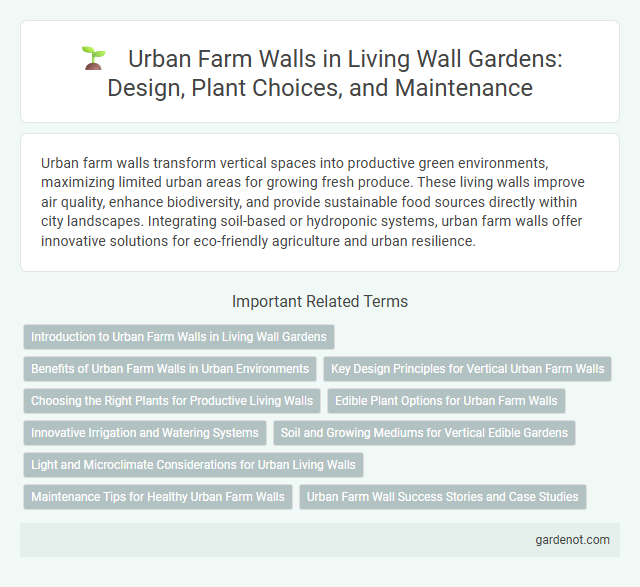Urban farm walls transform vertical spaces into productive green environments, maximizing limited urban areas for growing fresh produce. These living walls improve air quality, enhance biodiversity, and provide sustainable food sources directly within city landscapes. Integrating soil-based or hydroponic systems, urban farm walls offer innovative solutions for eco-friendly agriculture and urban resilience.
Introduction to Urban Farm Walls in Living Wall Gardens
Urban farm walls transform vertical spaces into productive green zones by integrating crops, herbs, and vegetables into living wall gardens. These walls promote sustainable urban agriculture, improve air quality, and enhance biodiversity within city environments. By utilizing hydroponic systems and modular designs, urban farm walls maximize space efficiency while providing fresh, local produce year-round.
Benefits of Urban Farm Walls in Urban Environments
Urban farm walls enhance urban environments by improving air quality through natural air filtration and absorbing carbon dioxide. They contribute to local food production, reducing the carbon footprint associated with transportation of fresh produce. These vertical gardens also mitigate urban heat island effects by providing natural insulation, lowering surrounding temperatures and increasing biodiversity in densely populated areas.
Key Design Principles for Vertical Urban Farm Walls
Urban farm walls require careful selection of moisture-retentive substrates and lightweight, durable materials to support plant health and structural integrity. Incorporating modular irrigation systems and adequate sunlight exposure ensures optimal growth and efficient resource use. Integrating biodiversity by combining multiple crop species enhances ecosystem resilience and maximizes vertical space utilization.
Choosing the Right Plants for Productive Living Walls
Selecting the right plants for an urban farm living wall involves prioritizing species with high yield and adaptability to vertical growth conditions, such as herbs, microgreens, and leafy greens like kale and lettuce. Plants with shallow root systems and strong resilience to variable sunlight and wind exposure ensure sustainable productivity in confined wall spaces. Incorporating drought-tolerant varieties and native plants reduces water consumption and supports local biodiversity in vertical farming systems.
Edible Plant Options for Urban Farm Walls
Urban farm walls thrive with edible plants like leafy greens, herbs, and compact fruiting varieties such as cherry tomatoes and strawberries, maximizing limited vertical space for fresh produce. Microgreens and climbing beans also enhance yield and nutrient density in urban environments. Choosing drought-tolerant and low-maintenance species ensures sustainability and consistent harvests on vertical farm installations.
Innovative Irrigation and Watering Systems
Urban farm walls utilize advanced irrigation technologies such as drip systems and capillary mats to optimize water efficiency and reduce waste. These innovative watering solutions incorporate smart sensors and automated timers that adjust water delivery based on real-time soil moisture and climate conditions. Integrating sustainable water recycling and rainwater harvesting further enhances resource conservation while supporting high-yield vertical agriculture.
Soil and Growing Mediums for Vertical Edible Gardens
Urban farm walls utilize specialized soil and growing mediums that optimize water retention, aeration, and nutrient delivery for vertical edible gardens. Lightweight, well-draining substrates like coco coir, peat moss, and compost-enriched mixes support root health and maximize crop yield in confined spaces. These growing mediums are often combined with hydrogel polymers or vermiculite to maintain moisture balance, ensuring sustainable plant growth in urban environments.
Light and Microclimate Considerations for Urban Living Walls
Urban farm walls require careful light exposure to optimize photosynthesis and ensure healthy plant growth, typically needing 4-6 hours of direct sunlight or supplemented artificial lighting in shaded areas. Microclimate factors such as humidity, temperature, and airflow must be managed to create a stable environment that minimizes plant stress and maximizes yield. Incorporating reflective surfaces and ventilation systems in urban living walls enhances light distribution and air circulation, promoting sustainable urban agriculture.
Maintenance Tips for Healthy Urban Farm Walls
Regular watering tailored to plant species and proper drainage prevent root rot and promote robust growth in urban farm walls. Use high-quality, nutrient-rich soil and apply organic fertilizers monthly to sustain plant health and productivity. Inspect plants weekly for pests and diseases, removing affected foliage promptly to maintain a thriving living wall ecosystem.
Urban Farm Wall Success Stories and Case Studies
Urban farm walls have transformed cityscapes by integrating sustainable agriculture within limited urban spaces, significantly improving local food security and air quality. Case studies such as the Brooklyn Grange in New York showcase how modular living walls yield high crop density while reducing urban heat island effects. Successful implementations highlight the role of technology in optimizing water usage and plant health, driving economic and environmental benefits in metropolitan areas.
Urban farm wall Infographic

 gardenot.com
gardenot.com